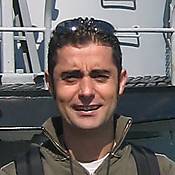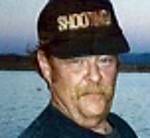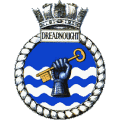You are viewing the archived version of the site.
Go to modelshipwrights.com for the current dynamic site!
Go to modelshipwrights.com for the current dynamic site!
1⁄700U.S.S. Brooklyn CL-40
7
Comments
"The detail on the Niko Model kit is very nice, sharp, with a minimal amount of cleanup."
the build...
I knew right away that I wasn’t going to build the model as Nashville, but most likely as the U.S.S. Brooklyn. Hey, I was born in New York, what do you expect? Another reason was the camouflage scheme. Nashville wore Measure 21 throughout her post-1942 career, and overall Navy Blue was simply too dark for a model with this much detail. I decided on Measure 22, a graded pattern of Navy Blue and Haze Gray, but that left me with only two choices for ships, the U.S.S Savannah and U.S.S. Brooklyn. Savannah was heavily damaged at Salerno in 1943, and her physical appearance changed dramatically after her refit, so the process of elimination brought me to the U.S.S. Brooklyn.Building a ship model, especially a highly-detailed, yet small model, requires a different approach. Typically, I’ll paint as I go and build from centerline of the ship outwards to the deck edge, and this model was no different. The hull was primed with Mr. Surfacer 1000, and the hull sides were sprayed with White Ensign ColourCoats U.S. Navy 5-N Navy Blue. I typically don’t use enamels, but I’ve heard great things about these colors and decided to give them a try. The paint sprayed extremely well, and after 24 hours of drying time, I masked the hull sides and sprayed the graded portion of the bow and the vertical surfaces on the main deck. Another 24 hours elapsed before I free-sprayed the 20-B Deck Blue on the horizontal surfaces, carefully trying to avoid overspray. Afterwards, I touched up the Haze Gray vertical surfaces with a fine brush.
Most ship modelers will tell you they build upwards and outwards from the ship’s centerline. Once the hull was painted, I started building the superstructure, level by level. I added the bridge levels, turrets, funnels, and fire-control directors to the hull before I started adding details.
Building a large warship can be a tedious process, especially late World War II era ships, covered from stem to stern with a wide array of AA weapons. The Brooklyn was no exception, and I spent the majority of my time building 40mm Bofors and 20mm Oerlikon guns. The 40mm guns weren’t too tough, but those tiny 20mm Oerlikons were a chore. Niko provides them as multi-fold photo-etched parts, and thankfully, provide a few spares on the fret, too. I lost several of these tiny little guns, too much pressure with the tweezers and ZING, off into space. They’re so small, in fact, that looking for them was pointless. Fortunately, I was able to bend the required number and actually had one left over!
After the AA guns were complete, I started on the midships searchlight platform. This tiny scaffold-like structure required some delicate handling. Did I mention 1/700 scale is tiny? After finishing the platform, I worked on the catapults and Kingfisher floatplanes. Each aircraft was assembled, painted, and decaled, then attached to the catapults and set aside.
Adding each of the pre-assembled, pre-painted parts really brought the ship to life, but it was still lacking something. At this point, the model was getting too fragile to handle, so I glued it to a wooden base. This would also end up as the display base later on, so I angled the model slightly on the base.
Now that I could effectively handle the model without risk of breakage, I started adding the final details to the model, those last few integral parts that not only give the ship its character, but also take it into the realm of ‘handle with care.’ I added the photo-etched mounts and arrays for the fire-control directors, the yardarms, funnel caps, various antennas, and finally, the rigging. I used a combination of surgical silk and Lycra thread, another wonderful product offered by White Ensign Models. By tacking one end of the thread to the model, I was able to stretch the Lycra thread to the yardarm and apply a touch of super glue. The resulting line will never sag, and actually offers a limited amount of flexibility in the event you catch a tweezers or other tool during the build. I painted the smaller parts with a fine brush, touching up a few ragged paint lines as I went.
 Jeff sprayed the model with Mr. Surfacer 1000 from a rattle can
Jeff sprayed the model with Mr. Surfacer 1000 from a rattle can After the mask was removed, some minor touchups were required around the hawse-pipes.
After the mask was removed, some minor touchups were required around the hawse-pipes. After spraying the hull sides with 5-N Navy Blue, Jeff masked the hull parallel to the waterline to account for the bow sheer. This typifies the Navy’s Measure 22 paint scheme.
After spraying the hull sides with 5-N Navy Blue, Jeff masked the hull parallel to the waterline to account for the bow sheer. This typifies the Navy’s Measure 22 paint scheme. All of the vertical surfaces on the main deck were painted with 5-H Haze Gray. Although the paint looks sloppy on some of the horizontal surfaces, there’s no need to worry, those areas will covered later by various layers of deck structure and turrets.
All of the vertical surfaces on the main deck were painted with 5-H Haze Gray. Although the paint looks sloppy on some of the horizontal surfaces, there’s no need to worry, those areas will covered later by various layers of deck structure and turrets. A coat of 20-B Deck Blue really adds to the contrast. Although they appear similar in the photo, the two colors are distinctly different.
A coat of 20-B Deck Blue really adds to the contrast. Although they appear similar in the photo, the two colors are distinctly different. Jeff built the model in levels, and added the heavier pieces to the model first to avoid breakage.
Jeff built the model in levels, and added the heavier pieces to the model first to avoid breakage.
Comments
Hi Jeff (again)
I really like reading out your article and it was interesting to see a different way of building these small "beasts" - perhaps that's why yours are better than mine
Flawless all the way, good water environment, nice touch with the BFM big tug, but... there are missing some crew members! IMHO if you are going to make a particular scene like this with the tug, you have to make it manned
Thanks for sharing it and welcome back to 1/700
Rui
JUL 07, 2008 - 04:47 AM
Adding the tug just made a good build even better. Just those little extras change the whole scene.
Thanks for sharing!
JUL 07, 2008 - 06:11 AM
Thanks for sharing more views of your excellent build Jeff. Always interesting stuff coming off of your bench, no matter what the scale. Looking forward to more.
JUL 07, 2008 - 11:20 AM
Fantastic model Jeff!!... Very clean model, well built and painted. The only suggestion I have (and I'm sure you would of done it eventually) would be to give the base edge a coat of paint or stain.
thanks for sharing,
Frank
JUL 08, 2008 - 08:23 AM
Ahoi Jeff!
good to see you building a ship model again!
Great looking build all round!
-agree with Rui that some crew populating the scene would add to the realism!
Jim Baumann
JUL 19, 2008 - 12:32 AM
Copyright ©2021 by Jeff Herne. _OPINIONS Model Shipwrights, KitMaker Network, or Silver Star Enterrpises. Images also by copyright holder unless otherwise noted. Opinions expressed are those of the author(s) and not necessarily those of Model Shipwrights. All rights reserved. Originally published on: 2008-07-07 00:00:00. Unique Reads: 9491













